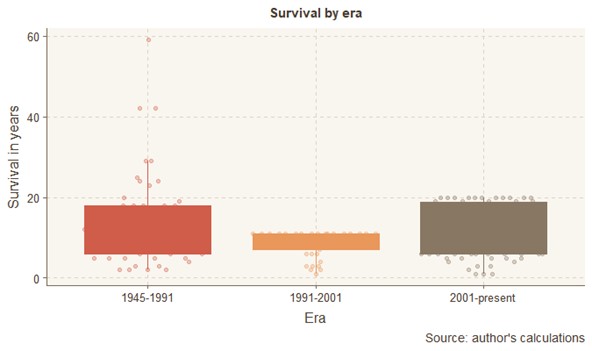
Groups that desire a radical transformation of society, often after a period of extreme upheaval, have been around for a long time. But now, they have the Internet.
When the leaders of Aum Shinrikyo–a Japanese millenarian cult responsible for the 1995 Sarin attack on the Tokyo subway system–were arrested, that organization met its demise. At its peak, Aum Shinrikyo had $2 billion in assets, a presence in seven countries, and 40,000 members to support its goals of overturning the world order in a climactic Armageddon-like conflict. Another group, Red Army Faction, aimed to create a global dictatorship of the proletariat, and had footprints in several countries. Red Army Faction disappeared in the late 1980s and later published a communiqué announcing its own disbandment after the fall of the Soviet Union. These groups and others like them had varied degrees of state support as proxies in their Cold War competition. Today, the Islamic State (ISIL) is anathema to all states, yet began another resurgence in 2020, two years after the group’s military defeat. What do all of these groups have in common? They are all violent millenarians: they seek nothing less than to violently transform global society. Millenarian groups (the name comes from the Latin millenarius–containing a thousand) are found in every religious group or sect and within secular ideologies. Groups that desire a radical transformation of society, often after a period of extreme upheaval, have been around for a long time. But now, they have the Internet.
These millenarian groups pursue goals that challenge the existence of a global order made up of states and the boundaries that demarcate them. The capacity of these groups to pursue anti-systemic goals varies with respect to balances of power in the international system and the capacities of millenarian leaders to engage with potential followers. Violent millenarian groups are a subset of violent extremist organizations (VEO). To be a violent millenarian the group must (1) exercise public goals of control outside internationally recognized borders; (2) advance a model of a desired future, a vision of a society transcendent of established Westphalian norms; (3) articulate how this international change can and should be brought about—how to get from (a) to (b); and (4) maintain flexible membership entry that is not subject to the control of national governments and is not restricted to any nationality, race, or ethnicity. This is important to policy makers because unlike traditional VEOs, their goals transcend defined recognized boundaries (either demarcated states or historical land claims). Therefore, violent millenarian groups will seek refuge globally, are comfortable conflict hopping, and cannot be eliminated by simply consolidating a finite area of occupation. Recent shifts in global balances of power–and especially changes in communications technology–combine to extend these groups’ lifespans. This technological change–and the associated development of inter-connected online communities–enables them to survive military and police assaults that previously ended their existence.
Since 1945, there have been 105 globally-oriented violent millenarian groups. Using big data content analysis of United Nations security reporting, three disruptions affected violent millenarian group survival. These disruptions occurred in 1945, 1991, and 2001.
This graph depicts the difference in outcome longevity by era. Two takeaways from the graph are that groups in the first and third era had significantly longer lifespans than those in the middle era. The reasons for this variance come from two master variables: shifts in international norms and access to connective technology, Second, nearly all groups since 2001 are still active. A violent millenarian is placed in each specific era based on the year they enter the Uppsala Conflict Data Program (UCDP) dataset. For instance, ISIL entered the UCDP in 2012, therefore they belong to the Post-9/11 era. Millenarian groups that entered the UCDP dataset between 1991-2001, have lifespans significantly shorter than if they did before 1991 or after 2001. This difference is explainable.
Groups before 1991 were useful to state patrons. About 80-percent had support from a state. This relationship boosted survival prospects, leading to longer lifespans. Their use to states fell in 1991 after the collapse of the Soviet Union. Only about 20-percent of groups during this time had state support. The overwhelming dominance of the United States between 1991-2001 meant neither the United States nor other countries needed to rely on violent proxies to balance their adversaries. This change forced millenarian groups to pursue counter-systemic goals alone. After 2001, the United States continued to dominate the international system, but connective technology–such as social media and mobile internet access–matured to the point of becoming a new survival mechanism. This advance allowed millenarian groups to maintain their counter-systemic goals, and maintain survivability without external support.
Of the 37 millenarian groups to emerge after 2001, only one has been eliminated. This trend of prolonged survival is concerning to those who seek to contain them. Most research on these violent groups focuses on the ways in which the wars and conflicts these groups participate in end more so than the termination of the groups themselves. Groups like ISIL have not just outlived their original conflict, but secondary ones as well. A phenomenon coined conflict hopping helps global millenarians accumulate support and resources. Since these groups have global goals, they are not concerned about the survival of the country in which they fight. These organizations also use social media, internet monitoring, and dark money to form, and manage, satellite groups in other countries, extending their reach and resilience.
Now the world faces a new wave of violent religious groups that seek to remake the global order.
Since the 1880s, the world has gone through waves of global violence, such as anarchist assassinations that killed United States President McKinley and the assassination of Austro-Hungarian Archduke Ferdinand that ignited World War One. These waves went through periods of expansion and contraction before eventually dying off. Now the world faces a new wave of violent religious groups that seek to remake the global order. Unlike their predecessors, contemporary millenarians have new ways to survive. With violent far-right movements becoming more prevalent, the world is likely on the cusp of its next wave of violence. This new wave is exacerbated by the likely global bipolarity. If the current trend of greater survivability prevails, the world could see two sustained waves of violence manifesting both concurrently, and indefinitely.
Understanding that millenarian organizations operate through a counterintuitive cost-benefit analysis, and that analysis is dictated by exogenous factors, is important to policy makers focused on countering violent non-state groups. In particular, the stories of ISIL, Aum Shinrikyo, and Red Army Faction suggest an eerie similarity in behavior and actionable conclusions for policy makers: millenarian organizations can survive as long as they maintain message-producing mechanisms.
This idea, although simple, focuses not just on the host country but also on unconsolidated neighbors and ideologically compatible entities as well, These ideologically compatible entities used to be primarily nation states, but have increasingly been wealthy individuals or charitable organizations. Many vulnerable states lack a capacity to identify growing millenarian groups outside their borders that may draw resources from their citizens. Often, states susceptible to external infiltration are embroiled in their own conflicts and have few resources available to counter what officials may perceive as more distant threats. But these states are susceptible to these groups’ influences and may potentially become their new primary homes. Further, since these states are often unconsolidated, they (a) lack an ability to credibly and successfully challenge the group and (b) may provide neutral territory for the group to consolidate material and financial resources that they couldn’t in cyberspace. These conditions lead states to a new international focus on consolidation.
This understanding of how millenarian groups emerge, and spread should also inspire state powerbrokers to pause and consider global counterinsurgency/terrorism policy. External meddling—while effective in stopping these groups by controlling technology—has also inadvertently created an environment for these groups to thrive. An example was the environment created after the U.S. invasion into Iraq that left ungoverned spaces ripe for unrest and power struggles. The U.S. policy to dismantle the Iraqi Army inadvertently sent experienced fighters to find employment elsewhere. While some went to nationalist groups like Jaysh Rijal al-Tariq al-Naqshabandia, others to went millenarian groups like ISIL. This dispersion made the millenarian ISIL stronger, more quickly than if the army had stayed intact and the fighters had remained otherwise engaged. The different lies in their ability to be defeated. Nationalist groups can be defeated by consolidating the physical area they reside. Millenarian groups have goals that transcend boundaries requiring a much broader, and more complex containment strategy.
External support for millenarian groups was prevalent and critical to foreign policy during the Cold War era. Since the two superpowers were in competition for global influence, the anti-systemic behavior and goals of these groups were less concerning. The two more recent eras, however, have proven to be an environment less accommodating. Present in all eras, states, specifically superpowers, have sought to identify friendly opposition forces as they have mounted challenges to regimes. Aid to these groups often helps the state advance toward an objective temporarily but ultimately only latently provides survival mechanisms, and subsequently prolonged outcomes, to aided groups. These resources, similar to those provided to groups like Red Army Faction or the Cambodian Khmer Rouge, externally propped up groups that were incapable of surviving on their own. This support emboldens millenarian groups that survive beyond their utility to their state sponsors.
We are on the verge of a test. The geopolitical environment is trending toward bipolarity, while, at the same time, connective technology is becoming even more accessible. As China rises and contests U.S. reign as hegemon, millenarian organizations will shift their behavior to ensure more positive outcomes. An example of this already taking place is ISIL’s pivot in addressing the oppressed Uyghur minority in China. Early in ISIL’s lifecycle, the group publicly supported the freeing of Uyghurs, urging them to join the global caliphate. This has changed recently. Since February 2017, ISIL almost entirely shifted away from Uyghur support and instead promoted a more China neutral message. This shift indicates that ISIL is potentially working to bandwagon with China in a balance against the United States.
Through connective technology, contemporary groups will maintain more autonomy than the millenarian groups in the previous bipolar era. With this, we can expect that relationships between states and counter-systemic groups will reemerge with the exception that, now, the relationship will be more transactional than classical principal-agent dynamics. That is, where Red Army Faction began to dissolve after losing its utility to the state, new era groups will support states only when their short-term goals align. Further, new era relationships will be finite and sporadic. In other words, millenarian groups will engage in short-term partnerships with the state only until a task is complete and then disassociate after the task is complete.
This transactional relationship should not be confused with equality. Rather, state/non-state relationships are trending away from interdependency in lieu of reciprocity. We should expect to see millenarian groups behave as “free-agents,” transitioning between supporters (both state and non-state) and going through periods without any external support. This new era will make counter-systemic groups even more resilient than they are now. As long as there is a globally stratified system, there will be violent millenarian groups. Their relative power, behavior, and resilience are dictated by the environment around them. Despite the changing environment, these groups have remained fundamentally the same. This essay represents an attempt to understand the constraints and opportunities imposed on these groups. Millenarian groups are developing at a predicable rate, but they are no longer dying. If the current trend of greater survivability prevails, the world will likely see sustained waves of violence manifesting both concurrently and indefinitely. The potential damage of this likely scenario should not be underestimated.
Jesse Humpal is a Major in the U.S. Air Force currently assigned to Joint Special Operations Command. He recently successfully defended his dissertation at Northwestern University, earning his doctorate in Comparative Politics and International Relations. His research interests focus on Terrorism, Failed States and Conflict.
The views expressed in this article are those of the author and do not necessarily reflect those of the U.S. Army War College, the U.S. Army, the U.S Air Force or the Department of Defense. Moreover, this study was conducted in strict adherence with Institutional Review Board standards and rules set by Northwestern University.
Photo Credit: Background photo created by jcomp – www.freepik.com






Rather than focusing on the sub-category of “millenarian” (etc.) movements, should we not, instead, be concentrating more on the super-category of “revitalization movements,” for example, as described in “Britannica” here?
“Revitalization movement: Organized attempt to create a more satisfying culture, with the new culture often modeled after previous modes of living. Nativistic, revivalistic, messianic, millenarian, and utopian movements are all varieties of revitalization movements, according to anthropologist Anthony F.C. Wallace, who introduced the term. Any given movement may contain elements of several of these varieties.
Social scientists generally agree that revitalization movements are societal responses to excessive stress. However, several mutually exclusive theories have been proposed to explain the generation of a revitalization movement: acculturation holds that conquest and other forms of hegemony generate utopian movements; social evolution views revitalization movements as expressions of empowerment by disadvantaged classes or groups; and absolute deprivation posits that dissatisfaction with a low standard of living leads people to adopt a revolutionary ideology. The most widely accepted theory, relative deprivation, suggests that revitalization movements may occur when a significant proportion of a society finds its status and economic circumstances trailing those of the rest of society, even if the dissatisfied group has a relatively high standard of living according to independent economic measures or in comparison to its past standard of living.”
Bottom Line Thought — Based on the Above:
Once we consider our problems today — and especially those here at home — more in terms of “revitalization movements,” only then, I suggest, might we:
a. Understand the true nature and full scope of our problems and
b. Finally admit that these relate more to such things as adverse “societal responses” (to include our own society’s such responses) “to excessive stress;” this such stress — experienced both here at home and there abroad — occasioned by the U.S./the West’s post-Cold War efforts to transform the states and societies of the world (to include our own); this, so as to better provide for and better benefit from such things as capitalism, globalization and the global economy.
I wholly endorse the comment above. Millenarianism has religious connotations. It’s based on a belief in an impending prophesied apocalyptic end. Describing communism as millenarian is just strange, communists do not believe in a supernaturally predestined utopia, they believe that the world we get is the one we create. And to reiterate the very wise insights of the comment above, the way to immunize society against this sort of violence isn’t to hunt it down and stamp it out. It’s to address the material conditions of our country and see that the rule of law is applied justly, and our resources serve everyone’s interests.
America is facing a crisis of legitimacy. Until Justice is established this country has no claim to popular sovereignty. https://www.yalelawjournal.org/forum/the-punishment-bureaucracy